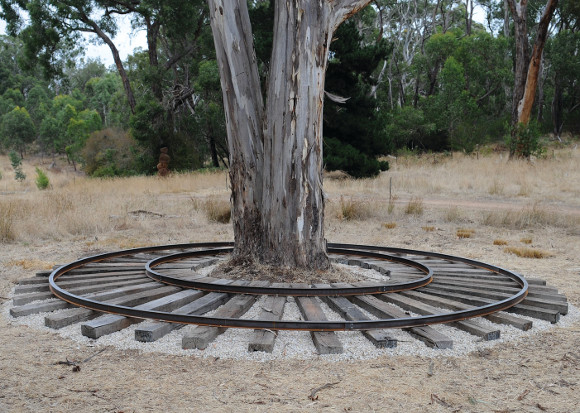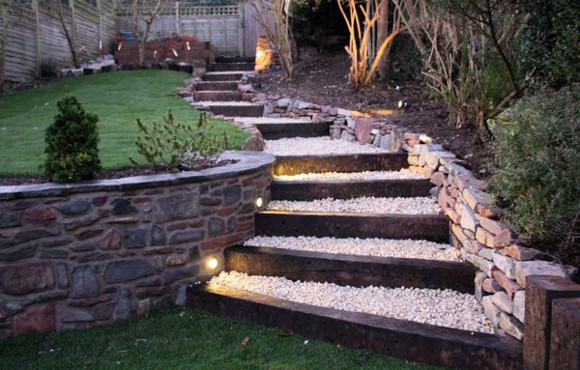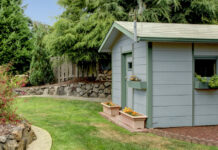Railway sleepers are an enormously popular garden building material. They look absolutely beautiful, they’re rugged, they last more or less forever when properly maintained and they play a part in all sorts of creations from garden steps to raised beds to basic garden furniture. Simply pile a load of them up and you’ve got some wonderfully simple seating. Or use two sets of two topped with a piece of wood, glass or even sheet metal to make an outdoor coffee table.

They’re versatile, good looking and as solid as a rock – so what are wooden railway sleepers for, where can you buy them, what do they cost, how can they be used and how do you preserve them to keep them in great condition over the years?
About railway sleepers
What are railway sleepers used for? They’re laid horizontally under the metal railway tracks to hold them in place at the right gauge. As such they’re the backbone of rail travel and millions of them are used every year to build new lines and maintain existing ones. While other materials have been tried and tested wood seems to work the best, perhaps because unlike concrete it’s slightly flexible.
We love this little piece of research carried out by a clever chap on the railway-sleepers website. Curious about how many sleepers there are in Britain, he decided to find out. Here’s what he discovered:
“My first source was a colleague, a man who has been working on the railway for many years. He had no idea when I asked him, but helpfully said that in one chain there were roughly 22-23 timber railway sleepers. So, with there being 80 chains to one mile, all I did was multiply 22.5 by 80, with the result of 1,800 sleepers per mile.
My second source was the Office of Rail Regulation. They publish a Current National Rail Trends yearbook (downloadable). During the period 2010-2011, it claimed that there was 15,777km of track open to both passenger and freight traffic, this equates to roughly 9,803 miles of track.
Armed with these figures, I multiplied 9,803 miles by 1,800 sleepers per mile to give me an approximation of 17,645,400 railway sleepers on open railway in the UK. This is only an approximation, as it doesn’t cover sidings, depots, etc. It also assumes that all terrain is the same, and that all the railway sleepers are made of the same material, and that they have all been installed 100% accurately.”
Great fun! In fact the entire Railway Sleepers website is an excellent resource for anyone interested in the fine detail. Sleepers might seem simple enough but there’s a lot more to their history than meets the eye.

Where to buy railway sleepers
You can buy new or used sleepers. These days the new ones come in a variety of guises:
- New shaped and profiled sleepers, some with fancy edges
- New pine sleepers
- New oak sleepers
Used and reclaimed sleepers tend to have a lot more personality, each unique and ready-weathered. They come in anything from untreated hardwood to treated softwood, and a variety of timber types including pine, oak, jarrah, azobe and karri.
All you need to do is Google it and you’ll find numerous places to buy railway sleepers, including reclamation yards and garden centres, fencing suppliers, builders merchants and auction websites. It’s obviously a booming product, and prices vary enormously – you can pay as little as £10 for a perfect, new untreated sleeper or more than £20 each for beautiful used ones.
Creative uses for railway sleepers
With a multitude of uses, sleepers are a gardener’s best friend. But you can also use them indoors – there’s no reason why you can’t create indoor furniture and features using them, for example, as a gorgeous, chunky mantelpiece, a rock-solid settee or bed base and even a dining table.

They make brilliant pedestals to sit beautiful pottery, sculpture and other precious objects on. If your walls are strong enough – and they’d have to be pretty strong – you could get a chippie to attach them skilfully and create big, bold, beautiful floating shelves. And you can lay them either horizontally or vertically.
Here are 18 cool ideas for using railway sleepers in the garden
- Raised beds filled with soil and plants
- A raised garden pond, building a wooden container to take a pond liner
- An entire garden paved with them instead of flagstones, gravel or paving
- Lawn edging
- To make walls to divide your garden into different ‘rooms’
- As a pillar to stand a bird feeder or birdbath on, or to stand an outdoor sculpture on
- Wood carving – if you’re ambitious and skilled you could carve a totem pole
- Garden benches, demarked seating areas, seats and tables
- Pile them up to create a giant wooden Jenga-like garden sculpture, or your own miniature Stonehenge, a maze
- Line a pit with them to make a semi-subterranean seating area
- A composting area
- A children’s sandpit
- Steps
- To mask ugly stuff like compost heaps and garden tools
- As super-strong fencing, or as an alternative to a low brick front garden wall
- As bollards to protect your verge
- To build terraces, making a steep garden useable
- The used ones are so attractive, especially when really worn, that you could dig a hole, stick one in and set it into the ground with sand and cement for an instant garden sculpture, all on its own. Stand a beautiful rock on top and it’ll look even better. Create a random collection or straight line of three or five sleepers with different rocks on top for an extra special effect
How to preserve wooden railway sleepers
Like all wood, sleepers will eventually rot and fade when exposed to the weather. To prevent them falling to bits before their time, you need to use a good wood preserver. But first you need to know what wood your sleepers are made of: are they hardwood or softwood, and have they already been preserved or are they untreated? Once you know that, you can get busy protecting them from wear.
Hard or softwood sleepers?
We’ve already written in detail about the difference between hard and soft woods. Here’s a link to our post to help you decide which is best for your garden and the purpose for which you want to use sleepers.
No to creosote… but yes to Creosolve
Sleepers were traditionally preserved and protected with creosote, but it’s nasty stuff and not recommended these days. Barrettine Creosolve delivers the same effect in an oil-based creosote substitute perfect for exterior wood. It’s safer and more environmentally friendly than the old fashioned stuff and it comes in light or dark shades, ideal for creating different finish effects. But the best thing of all is this: it’s actually been designed to work beautifully on rough wood, which means if you want to maintain that lovely worn texture you get with used sleepers, you can.
Aside from that, we have an entire department dedicated to railway sleeper maintenance. They’re products we’ve chosen specially because they are perfect for protecting new and old wooden railway sleepers from rot, mould and fungi, and from the worst ravages of water and sunshine.
More queries abut railway sleepers?
For more information about railway sleeper treatments and their uses, contact our team of resident experts who are always on hand to help with project advice and product recommendations. Alternatively, see our railway sleeper FAQ page which covers many of the most commonly asked questions about railway sleepers.
We love to see before, during and after photos of any wood finishing project. If you would like to share your project pictures with us and our followers, you can either send us some photos or share on our Facebook, Twitter, Pinterest or Instagram pages.





Had a landscape gardener in, used 2 railway sleepers as steps to higher level garden, have faded, look awful. Do not know what type they are, smooth background looked pale with different hues of brown in, looked different depending how sun hit them or overcast. Loved looking at them, now look like one pale colour, is there anything to restore, or do we write them never treated them as we thought they would already have been done, only 2 years old and very disappointed with outcome.
Good Morning Janice,
Do by any chance know what products the landscape gardener used to treat then with ? If you could get int ouch via wfd.advice@wood-finishes-direct.com with some photos I will be happy to take a look and see what I am able to advice for you.
Kind regards Samantha.
Hi I have recently built a sleeper wall using new hardwood sleepers, next to the wall is a new slabbed patio. When it rains I get a brown stain on the slabs from the sleepers. Any ideas what I could seal the sleepers with to stop this happening? Thanks
Good Afternoon Michael,
Can you tell me if the sleepers have any treatment currently on them?
I suspect the brown staining is tannins leeching from the wood, possibly activated by the damp conditions or a wet period. Are you able to get int ouch via email with some photos to wfd.advice@wood-finishes-direct.com and I can take a look for you.
Kind Regards Samantha.
We have new untreated oak sleepers just laid as a deck. Thinking we need to clean well with white spirit and then apply a preservative. They are currently very yellow and want a grey/brown shade. Considering some shades from the Osmo Natural Oil Woodstain range – will these do the job
thanks
Hello Carol,
I am so sorry we haven’t got back to you sooner. In answer to your question yes the Natural Oil Woodstain from Osmo will be a possible option. The only thing to mention is how rough or smooth the wood is, as this will determine how much of the oil will be absorbed, if the wood is particularly porous then this could result in using far more than the coverage guidelines and become a costly project.
For something a little more cost effective you could also consider a coloured Decking Oil such as Barrettine Decking Oil this will give better coverage and is available in clear and coloured finishes.
If you have any further questions about either of the products or your project please do not hesitate to get back in touch.
All the Best Samantha.
Hi I am wanting to use sleepers for a border, the untreated ones seem to fit better with the colour theme, will they need to be treated or can I leave them untreated?
Good Afternoon Sabrina,
I would always recommend a preservative to be applied as the minimum. This will help to prevent mould, mildew and rot. I can recommend the Barrettine Premier Wood Preservative which also has some wax in it to help make the wood moisture repellent. The clear will darken the wood slightly to give the ‘wet look’
I hope that helps and if you have any further questions please do not hesitate to get in touch.
Kind regards Samantha.
Hi – we are about to make some (untreated) oak sleeper retaining walls, to divide 2 levels of lawn. So we have questions around:
1. best way to anchor and join sleepers
2. i read that 150mm stainless steel A4 screws should do it (but need to be SS as the chemicals in oak can badly corrode normal screws – correct?)
3. the retaining walls will be 1M high. Will the 150mm SS screws be enough, or do they need other fixings so they don’t collapse or move under weight of soil?
4. at the back of the oak sleepers, should we add a membrane so that the wood does not touch the soil directly?
5. how many years can we reasonably expect from new untreated oak sleepers
Many thanks…sorry for so many questions; your expertise is much appreciated!
Adam
Hello Adam,
Thank you for your enquiry. Whilst I can not help with the construction side of your project. I can advise on the care of the wood to help to prolong its life.
A membrane will certainly help, moisture is the biggest cause of damage to exterior wood and any thing that prevents contact with moisture will help. I would also recommend a quality Preservative. This will help to prevent mould, mildew and rot as well as make the wood moisture repellent with its wax content.
I hope that helps and if there is anything further that I can help with please do not hesitate to get in touch.
All the Best Samantha.
Good afternoon, I am attempting my first landscaping adventure and due to cost have bought softwood Green tanilised sleepers for a raised bed. I set my post in the ground in concrete and have used timberlock screws to attach the remaining sleepers to them. My question is 3 of the 5 sleepers set in the concrete seem to be damp around the bottom I’m concerned they’ve not been treated properly and have now wasted my time and money. Any advice or feedback would be great.
Hello Daniel,
Would you be able to send me some photos of the issues that you are having. You can send them to wood@finishes.direct and I will happily take a look for you.
We do often recommend the application of a good quality Preservative despite the tanalisation, to ensure that complete protection is provided for the wood. And then a coat of exterior oil such as Decking Oil will help to make the wood water repellent and slow down the silvering process.
Essentially you want to protect the wood from water ingress as this is the cause of mould and algae forming on the wood and in the long run rot can cause serious damage. I hope that helps and if you have any further questions please do feel free to put them in the email to the address above.
Kind Regards Samantha.
Can I use reclaimed railway sleepers previously treated with creosote to construct a raised bed for growing vegetables?
Hello Roger,
Thank you for your inquiry, this is not something I know a lot about but from what I have read, direct contact with Creosote can cause harm to plants. But if the plants are a few inches away from the wood it should be fine. I have also read that any Creosote that runs into the soil may damage roots but will not be taken up by the plant directly. I wish I could give you a more committed answer but I wouldn’t like to misinform you as I know the time and energy that goes into growing your own. I do know that it is very difficult to remove Creosote from Sleepers if they are treated with this product. The treatment is likely to be deep into the wood. I hope you are able to find the answer, maybe an allotment website may know better.
Kind regards Sam.
Hi I’m building a planter out of new oak sleepers, my previous soft ones rotted after 8 years. I used to oil the outside of it annually. My questions is, should I treat the inside wall of the new oak sleepers before adding the soil or even line it with something. My previous soft wood planter was lined but only with a weed membrane. Also any ideas of how long I can expect the oak ones to last?
Thanks for your help
Regards
Steve
Hello Steve,
The more protection you can put in place for the wood the better. So a water proof membrane to avoid contact between the wood and the soil can only be a good thing. It is also worth applying a good quality Preservative to all sides of the wood before building the planter as this will help to prolong the life of the wood, this will protect against mould, mildew and rot.
And then a top coat of an oil-based product such as Barrettine Decking Oil to make the wood water repellent. An annual coat of the oil is great maintenance, so continue with that as you have been.
I can’t give an exact time for the life of the wood because it will be affected by weather and general wear and tear but if it is good quality solid oak and you keep up the maintenance well it should last 10 years or more. If you have any further questions please let me know – Sam.
@Admin
tell me what is good preserves for hard wood….?
i tried many of good preserves before but my wood is eventually rod and fade when exposed in rainy days …
Regards
Priyanka
Hello,
Many preservatives will protect from mould, mildew, woodboring insects, rot and more. But not against the fading effects of the sun. To help prevent your wood from silvering, you need to use an Oil that contains some UV protection. Most Decking Oils such as, Barrettine Decking Oil will have some UV Protection in them and regular maintenance coats will help to maintain the natural colour of the wood.
Hi,
I am needing advice on finishing my oak sleepers.
I have just completed a patio area in my garden and edged it with 12″ x 6″ X 72″ oak sleepers. These sleepers were treated with a wood preserver but I now want a finish. I would like a wet look mat finish. What product would you recommend??
The sleepers are exposed to sunlight (when we get it lol) and I would like to stop the silvering effect.
Please advise
Regards
Steve
Hello Steve,
Generally speaking the darker the finish the better UV protection the wood will have. However if you just want to keep them natural with a clear finish then a Clear Decking Oil would be your best option. Barrettine Decking Oil has UV protection in it, but it is worth keeping an eye on the wood and giving a maintenance coat when you feel that the wood is starting to fade.
Maintenance coats are easy to do just make sure the wood is clean and dry and you can re-apply the Decking Oil, we would love to see some photos if you get time to send some in – wood@finishes.direct